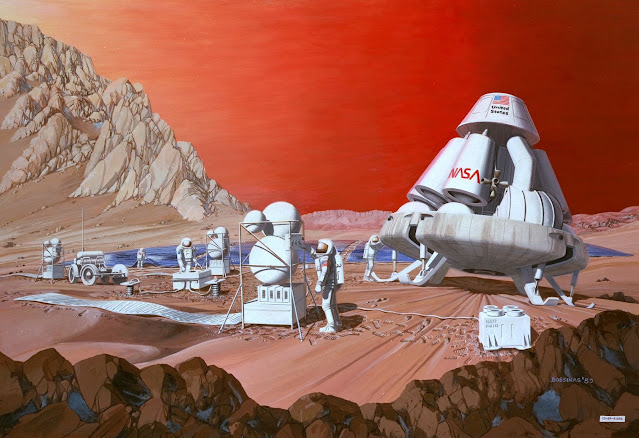When I think of alien worlds, Mars immediately comes to mind.
It's the one world that I may live to see astronauts land on,
and it's the one world that humans may colonize in this century.
and to think about Mars and human colonization.
Mars has haunted the dreams and imaginations of humankind
since we first gazed at the red planet.
It has been associated with war and bloodshed since ancient times because of its color.
Babylonians called Mars Nergal after their god of fire, war, and destruction,
and Romans named it Mars after their god of war. Google
Dreams of Mars
by Louise MacBeath Barbour
October 13, 2021
© M. Louise (MacBeath) Barbour/Fundy Blue
All Rights Reserved
The First Card in the Mars Attacks Trading Card Series, 1962
To See the Full Series Click
Here
From Earth, Mars is the most accessible place in the solar system,
although establishing a colony on Mars poses difficult challenges:
radiation exposure, isolation, low gravity, toxic soil,
very cold temperatures, and a lack of available water and oxygen.
NASA artist's conception of a human mission to Mars (painting), 1989
True color image of Mars taken by the OSIRIS instrument on the European Space Agency Rosetta spacecraft during its February 2007 flyby of the planet.
The image was generated using the OSIRIS orange (red), green, and blue filters.
Mars has always fascinated me.
When I watched the Eagle land on the moon on July, 20, 1969,
I was certain we'd have colonies on Mars by now.
My hopes were crushed by the lack of human space exploration over the last half century.
But on September 28, 2018, I felt renewed hope when Nature reported an exciting find.
Planetary scientists reported the discovery of liquid water below the surface
of Ultimi Scopuli at the base of Mar's south polar layered deposits.
The water existed in a 20 kilometer-wide lake about 1.5 kilometers
under a thick polar cap formed by layers of ice and dust.
The Mars Advance Radar for Subsurface and Ionosphere Sounding (MARSIS) survey
collected the data leading to the detection of water. Nature.com
Illustration of the European Space Agency's Mars Express Mission Showing its MARSIS Antenna
The European Space Agency conducts the Mars Express mission to explore Mars.
MARSIS is a radar instrument carried on Mars Express,
and it was designed to search for water, water-ice, or permafrost layers
The MARSIS principal investigator is Giovanni Picardi at Sapienza University of Rome.
Mars-Subglacial Water-South Pole Region
A view of the southern polar plain of Mars, with the Mars Express’s color-coded findings superimposed at the site where they were detected. The 12-mile-wide lake is believed to be about a mile deep.
The South Polar Ice Cap, Mars, Summer 2000
Layered Deposits at the South Pole of Mars
The ExoMars Trace Gas Orbiter captured this view
of part of the south polar ice cap on Mars on 13 May 2018
Mars Express detects water buried under the south pole of Mars.
MARSIS Survey
If Scopuli sounds familiar than you are likely a fan of Amazon's The Expanse,
a fabulous, critically acclaimed, science fiction series based on the James A. Corey novels.
The Scopuli was a Martian light transport freighter that is pivotal to the Expanse series.
On September 28, 2020 Nature reported more waterdetected beneath Mar's south polar layered deposits.
Since the initial report in 2018 was met with skepticism as well as excitement,
scientists collected additional data with the Mars Express orbiter.
Elena Pettinelli and her colleagues at the University of Rome confirmed the existence
of the first lake and the discovery of three more.
Altogether the lakes cover an area of 29,000 square miles
Radar Map from Mars Express
Showing One Large Subsurface Lake and Three Smaller Ones
Water is life, not necessarily for Martian life,
but rather to support humans living on Mars.
So I dream of a underground colony on Mars, one that extracts
potable water from the hypersaline brines in the subsurface lakes.
Such a colony would face other challenges.
An underground colony would solve the problems
of radiation exposure and and very cold temperatures.
Oxygen could be recovered from the Martian atmosphere by electrolysis,
a process that splits carbon dioxide into oxygen and carbon monoxide.
Low gravity is a big challenge, but I imagine that could be overcome
with centrifuge-like human living pods within the colony,
exercise, supplements, and perhaps genetic tweaking.
Cyanobacteria could be used to transform toxic soil into soil to support plant life,
and lab-produced meat substitutes could expand the variety of food available.
As for isolation, mixed sex colonists, space mission visitors,
and advanced communications, would help colonists deal with being so far from Earth.
I can see it!

A Rough Sketch of an Underground Colony Below Ultimi Scopuli
by Louise MacBeath Barbour
October 13, 2021
© M. Louise (MacBeath) Barbour/Fundy Blue
All Rights Reserved
My sketch for an underground colony is rough indeed!
I imagine a series of underground tunnels connected
by dome-covered elevators, one main and two adjacent,
with a separate dome and elevator leading to a nuclear energy plant.
I see humans living in a tunnel colony about 300 feet below ground,
and cyanobacteria and plants growing in a tunnel
several hundred feet below the human habitat.
Hundreds of feet deeper in another tunnel,
a factory produces oxygen and other life support systems are functioning.
Finally, in the lowest tunnel, a water production system
processes water several hundred feet above the underground lake.
I believe humankind's survival depends on expanding from our home planet Earth,
and establishing a colony on Mars is a necessary step.
Here's to a bright and successful future!
The International Space Station Orbiting above the Earth
Till next time ~Fundy Blue
On the Bay of Fundy© M. Louise (MacBeath) Barbour/Fundy Blue
All Rights Reserved































